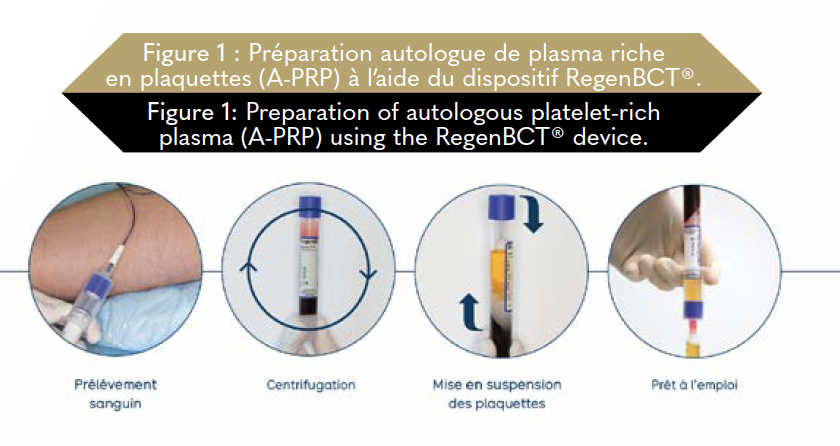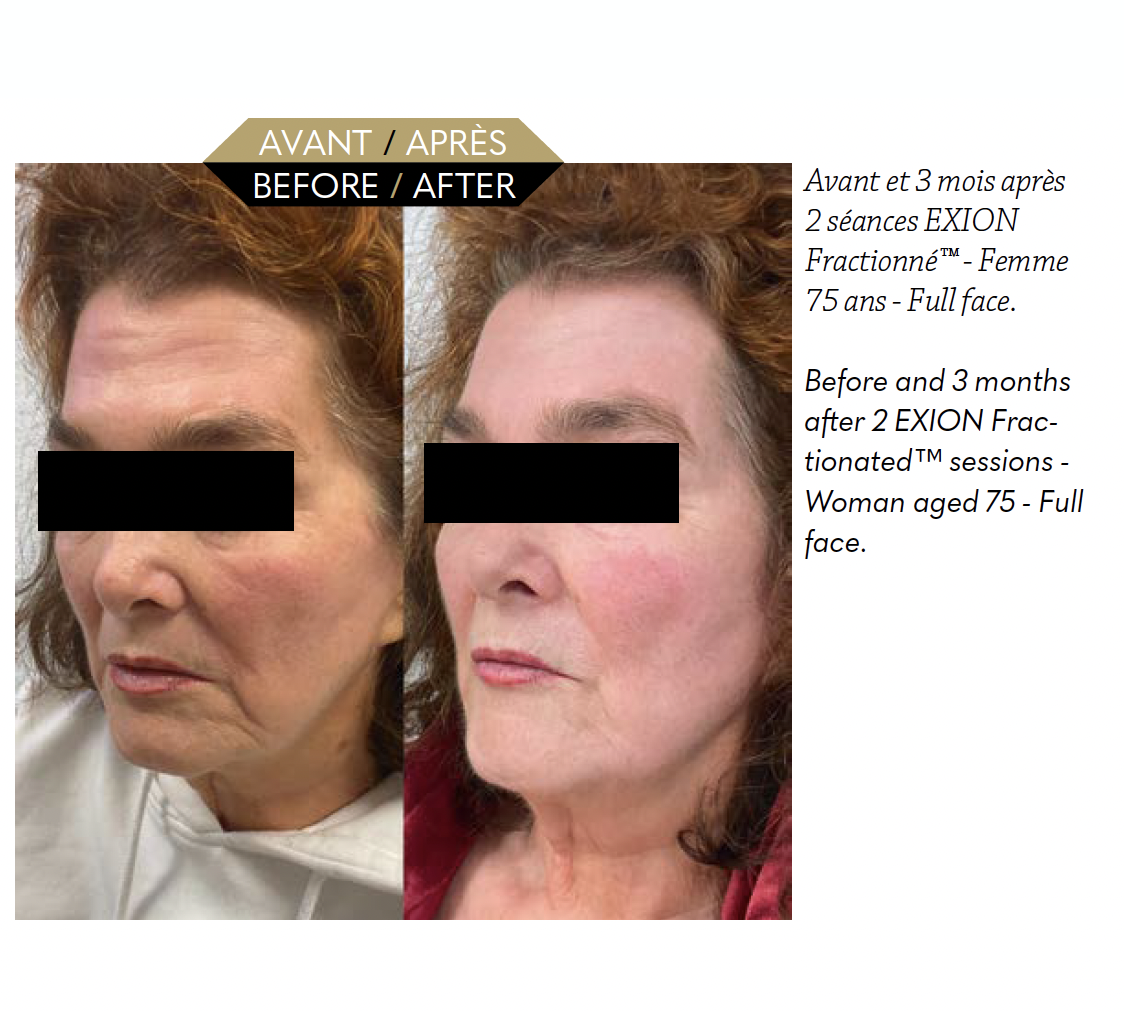Pr Barbara Hersant
Stronger, denser and richer hair [1-4]. The three main causes of hair loss are androgenetic alopecia, telogen effluvium and alopecia areata (spot baldness) [5]. To deal with any hair loss, an in-depth medical evaluation is essential and allows us to explore the different causes.
Platelet-rich plasma (PRP) is described as an autologous biological product from the patient’s blood. This therapeutic procedure is becoming increasingly useful in regenerative medicine due to its ability to stimulate and accelerate tissue regeneration [6].
 Essential components of PRP: growth factors
Essential components of PRP: growth factors
Each platelet contains more than 3,000 biomolecules. The activated platelet degranulates, releasing all of these molecules into the recipient tissue. The growth factors that are essential in PRP include: transforming growth factor (TGF β-1), platelet-derived growth factor (PDGF-αβ and PDGF-ββ), insulin-like growth factor (IGF), vascular endothelial growth factor (VEGF), and fibroblast growth factor (FGF-2). TGF β-1 and PDGF promote the proliferation of mesenchymal stem cells, while TGF β-1 also stimulates the production of extracellular matrix, particularly collagen. These factors primarily stabilise the damaged tissues, encouraging the local cells to migrate and divide, and increasing the synthesis of collagen and extracellular matrix, leading to the formation of fibrous conjunctive tissue and healing. VEGF and FGF-2 play a crucial role in stimulating the formation of new blood vessels that provide essential nutrients [7-9].
The various effects on the healing process are brought about by the interaction of each growth factor with the specific receptors located in the cell membranes of the target cells. They include chemotaxis, which attracts the cells, promotes cell migration and proliferation, and incites the cells to increase their regulation of protein production. Not only do they regulate cell migration and proliferation, but they also influence the reshaping of the extracellular matrix and promote angiogenesis, thus creating an environment that favours regeneration.
 One of the methods for preparing PRP
One of the methods for preparing PRP
The process, which aims to isolate the plasma and blood cell platelets, is standardised and reproducible. The RegenBCT® (Blood Cell Therapy) tubes employ a technology that uses a chemically-inert thixotropic separator gel, which allows us to isolate the plasma and blood cell platelets to produce PRP with a standardised composition. Before centrifugation, 10ml of blood is collected in a tube with an anticoagulant (sodium citrate). The sample is centrifuged at a force of 1,500g for 5 minutes. The centrifugation separates the blood components according to their density. The red blood cells, which are heavier, find themselves trapped at the bottom of the tube, below the separator gel. Next, the tube is tipped upside down several times to spread the platelets, which cover the gel in the plasma (Figure 1). In our laboratory, we use the RegenKit-BCT®, which allows us to obtain a standardised composition (Table I) from the same volume of blood.
Our protocol
We recommend using PRP as a complementary treatment for androgenetic alopecia, while encouraging patients to keep using their topical and/or oral treatments. We recommend three sessions spaced a month apart as an initial treatment, followed by two sessions per year for the rest of their life. PRP can be applied during and after a hair transplant to help the grafts to take and ensure their survival. It is administered by intradermal injection of 0.1 mL/cm², by mesotherapy using an injector gun. Studies suggest injecting subdermal boluses might be a favourable technique, as it is less painful and has a superior overall efficacy. The injections are performed using the nappage technique, with several small injections made in a line at intervals of around 1cm. The volume of PRP injected presents significant variations from one study to the next, but is generally between 6 and 20mL.
 PRP has several effects. It helps to increase the hair density by 10 to 20% [10, 11], slows down hair loss [12] and increases the thickness of the hairs [13]. However, it does not create new follicles and does not replace a hair transplant [14, 15]. l
PRP has several effects. It helps to increase the hair density by 10 to 20% [10, 11], slows down hair loss [12] and increases the thickness of the hairs [13]. However, it does not create new follicles and does not replace a hair transplant [14, 15]. l
References
1. Gkini MA, Kouskoukis AE, Tripsianis G, Rigopoulos D, Kouskoukis K. Study of platelet-rich plasma injections in the treatment of androgenetic alopecia through an one-year period. Journal of cutaneous and aesthetic surgery. 2014;7(4):213-9.
2. Ho A, Sukhdeo K, Lo Sicco K, Shapiro J. Trichologic response of platelet-rich plasma in androgenetic alopecia is maintained during combination therapy. J Am Acad Dermatol. 2020;82(2):478-9.
3. Juhasz MLW, Sukhdeo K, Lo Sicco K, Shapiro J. Stratifying clinical response to adjuvant platelet-rich plasma in patients with androgenetic alopecia. The British journal of dermatology. 2020;183(3):580-2.
4. Betsi E-E, Germain E, Kalbermatten DF, Tremp M, Emmenegger V. Platelet-rich plasma injection is effective and safe for the treatment of alopecia. European journal of plastic surgery. 2013;36(7):407-12.
5.Phillips TG, Slomiany WP, Allison R. Hair Loss: Common Causes and Treatment. Am Fam Physician. 2017 Sep 15;96(6):371-378. PMID: 28925637.
6. Marx RE. Platelet-rich plasma (PRP): what is PRP and what is not PRP? Implant Dent. 2001;10(4):225-8. doi: 10.1097/00008505-200110000-00002. PMID: 11813662.
7.Everts PA, Knape JT, Weibrich G, Schönberger JP, Hoffmann J, Overdevest EP, Box HA, van Zundert A. Platelet-rich plasma and platelet gel: a review. J Extra Corpor Technol. 2006 Jun;38(2):174-87. PMID: 16921694; PMCID: PMC4680757.
8. Eppley BL, Woodell JE, Higgins J. Platelet quantification and growth factor analysis from platelet-rich plasma: implications for wound healing. Plast Reconstr Surg. 2004 Nov;114(6):1502-8. doi: 10.1097/01.prs.0000138251.07040.51. PMID: 15509939.
9. Engebretsen L, Steffen K, Alsousou J, Anitua E, Bachl N, Devilee R, Everts P, Hamilton B, Huard J, Jenoure P, Kelberine F, Kon E, Maffulli N, Matheson G, Mei-Dan O, Menetrey J, Philippon M, Randelli P, Schamasch P, Schwellnus M, Vernec A, Verrall G. IOC consensus paper on the use of platelet-rich plasma in sports medicine. Br J Sports Med. 2010 Dec;44(15):1072-81. doi: 10.1136/bjsm.2010.079822. PMID: 21106774.
10. Gentile P, Garcovich S, Bielli A, Scioli MG, Orlandi A, Cervelli V. The Effect of Platelet-Rich Plasma in Hair Regrowth: A Randomized Placebo-Controlled Trial. Stem Cells Transl Med. 2015 Nov;4(11):1317-23. doi: 10.5966/sctm.2015-0107. Epub 2015 Sep 23. PMID: 26400925; PMCID: PMC4622412.
11. Uebel CO, da Silva JB, Cantarelli D, Martins P. The role of platelet plasma growth factors in male pattern baldness surgery. Plast Reconstr Surg. 2006 Nov;118(6):1458-1466. doi: 10.1097/01.prs.0000239560.29172.33. PMID: 17051119.
12. Singhal P, Agarwal S, Dhot PS, Sayal SK. Efficacy of platelet-rich plasma in treatment of androgenic alopecia. Asian J Transfus Sci. 2015 Jul-Dec;9(2):159-62. doi: 10.4103/0973-6247.162713. PMID: 26420936; PMCID: PMC4562137.
13. Sclafani AP. Platelet-rich fibrin matrix (PRFM) for androgenetic alopecia. Facial Plast Surg. 2014 Apr;30(2):219-24. doi: 10.1055/s-0034-1371896. Epub 2014 May 8. PMID: 24810134.
14. Li ZJ, Choi HI, Choi DK, Sohn KC, Im M, Seo YJ, Lee YH, Lee JH, Lee Y. Autologous platelet-rich plasma: a potential therapeutic tool for promoting hair growth. Dermatol Surg. 2012 Jul;38(7 Pt 1):1040-6. doi: 10.1111/j.1524-4725.2012.02394.x. Epub 2012 Mar 27. PMID: 22455565.
15. Takikawa M, Nakamura S, Nakamura S, Ishirara M, Kishimoto S, Sasaki K, Yanagibayashi S, Azuma R, Yamamoto N, Kiyosawa T. Enhanced effect of platelet-rich plasma containing a new carrier on hair growth. Dermatol Surg. 2011 Dec;37(12):1721-9. doi: 10.1111/j.1524-4725.2011.02123.x. Epub 2011 Aug 24. PMID: 21883644.
 Pr Barbara Hersant: MD PhD, Professor of plastic, aesthetic and reconstructive surgery at the APHP Henri-Mondor Hospital, practises regenerative and reconstructive surgery on the figure, face and genitals, as well as aesthetic medicine and surgery. Tenured member of the French Academy of Surgery.
Pr Barbara Hersant: MD PhD, Professor of plastic, aesthetic and reconstructive surgery at the APHP Henri-Mondor Hospital, practises regenerative and reconstructive surgery on the figure, face and genitals, as well as aesthetic medicine and surgery. Tenured member of the French Academy of Surgery.
More informations: dr-hersant.fr















